Bug Quiz 4
1/45
There's no tags or description
Looks like no tags are added yet.
Name | Mastery | Learn | Test | Matching | Spaced |
|---|
No study sessions yet.
46 Terms
Order: Trichoptera
Synapomorphies
2 pairs of membranous wings, usually with abundant hairs
Mouthparts mandibulate but reduced, palps well-developed
Holometabolous
Larvae aquatic, often make cases or nets
Holometabolous definition
Complete metamorphosis; a form of insect development which includes four life stages: egg, larva, pupa, and imago
Egg
Larva
Pupa
Adult stage (Imago)
Hemimetabolous definition
Partial metamorphosis; a form of insect development which includes three life stages:
Egg
Nymph
Adult stage (Imago)
These groups go through gradual changes; there is no pupal stage
Order: Trichoptera
Family: Hydroptilidae (Microcaddisflies)
Antennae short
HW narrow and pointed apically, often with fringed hairs that are clubbed
Ocelli sometimes present
Mesoscutellum flat and triangular
Very small
Usually very hairy (gray/brownish)
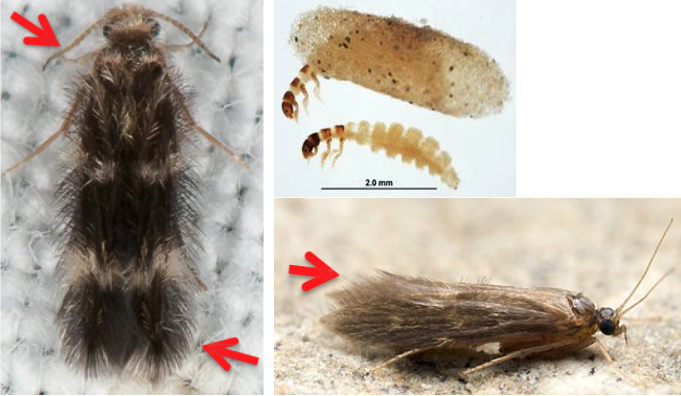
Order: Trichoptera
Family: Phryganeidae (Large caddisflies)
Antennae moderately long
Maxillary palps 4-segmented in males, 5-segmented in females
Ocelli present
Meso-tibiae with 2 preapical spurs (4 total incl. apical)
Usually among the largest caddisflies
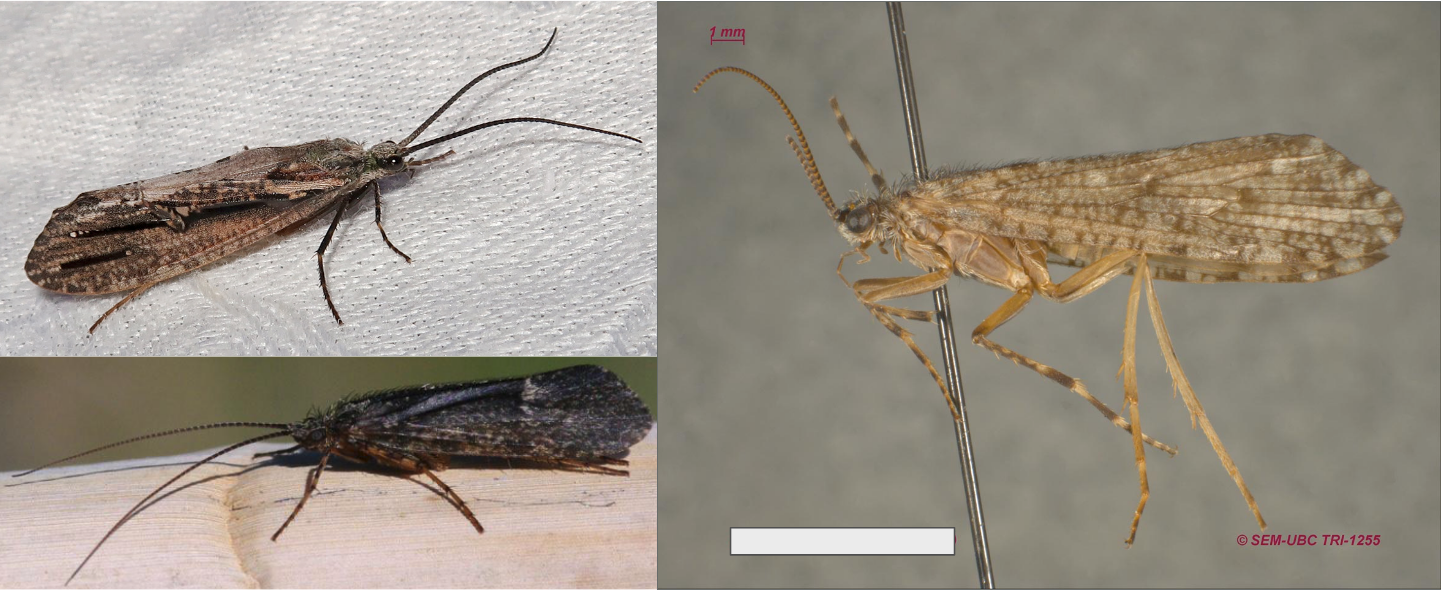
Order: Trichoptera
Family: Limnephilidae (Northern caddisflies)
Antennae moderately long
Maxillary palps 3-segmented in males, 5-segmented in females
Ocelli present
Meso-tibiae with 2 apical spurs and 1 preapical spur (3 total spurs)
Much larger than Hydroptilidae; medium/large
Usually more brown with dark markings
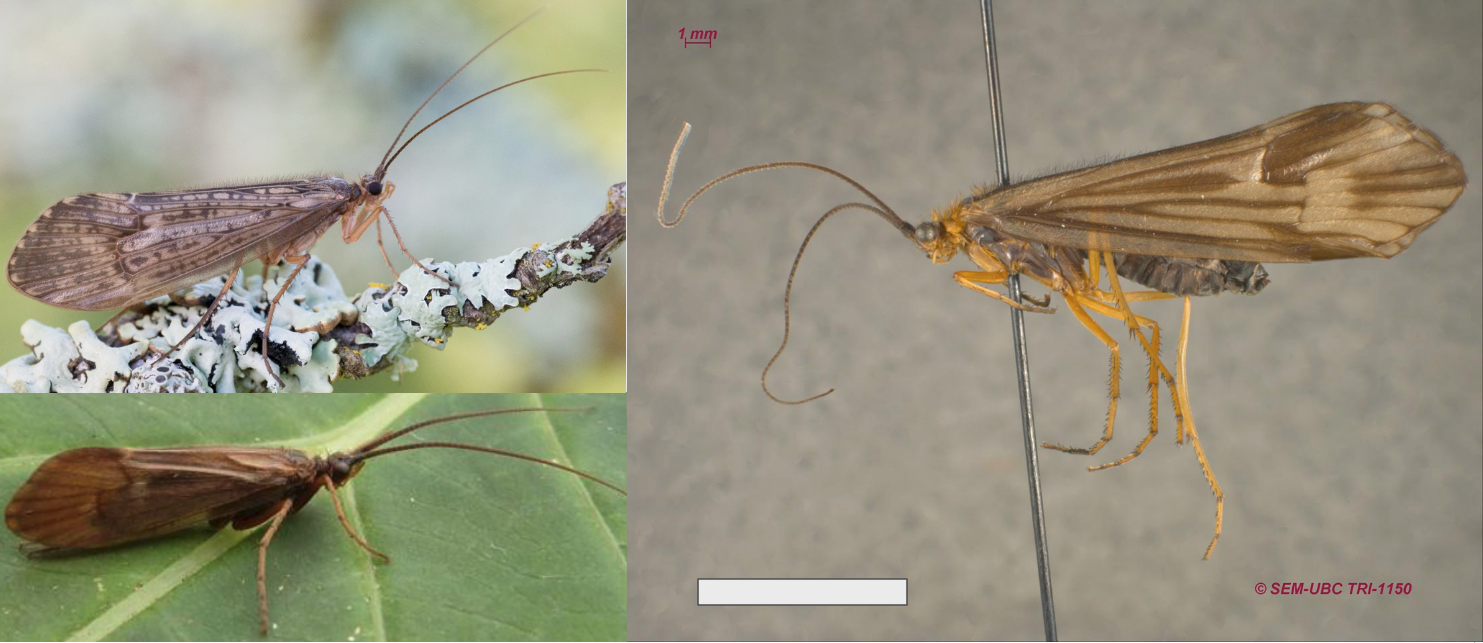
Order: Trichoptera
Family Hydropsychidae (Net-spinning caddisflies)
Antennae long
Maxillary palps with 5 segments in both sexes, last segment much longer than preceding segments and prehensile
Ocelli absent
Mesoscutum without warts
Much larger than Hydroptilidae; medium sized
Brownish, wings mottled

Order: Trichoptera
Family: Leptoceridae (Long-horned caddisflies)
Antennae very long
Ocellie absent
Maxillary palps with fewer than 5 segments, last segment similar in size to others
Mesoscutum with setal warts, separated by notch
Meso-tibiae without preapical spurs
Little/much larger than Hydroptilidae
Slender, often pale colored

Order: Lepidoptera
Synapomorphies
Wings with scales
Mouthparts modified into long coiled siphoning proboscis
Maxillary palps usually reduced but labial palps conspicuous
Fore and hind wing differently shaped
Knobbed antennae(?)
Order: Lepidoptera
Family: Hesperiidae (Skippers)
Antennae clubbed but also hooked at tip
Antennae widely separated at base
Meta-tibiae usually with middle spur
FW with R 5-branched but branches not stalked and all arising from discal cell
Fairly stout-bodied compared to Papilionoidea
Most hold the FW and HW at different angles while at rest
Rapid skipping flight
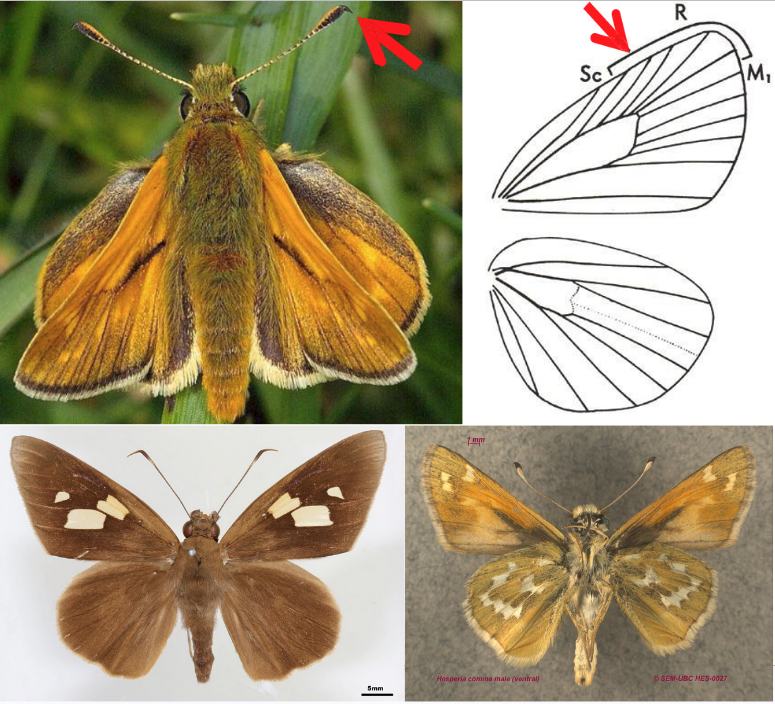
Order: Lepidoptera
Family: Papilionidae (Swallowtails)
Front legs not reduced
FW with R 5-branched
HW with 1 anal vein and usually with tail-like projection (not always!)
Size large, usually brightly colored with black, yellow, and other colors
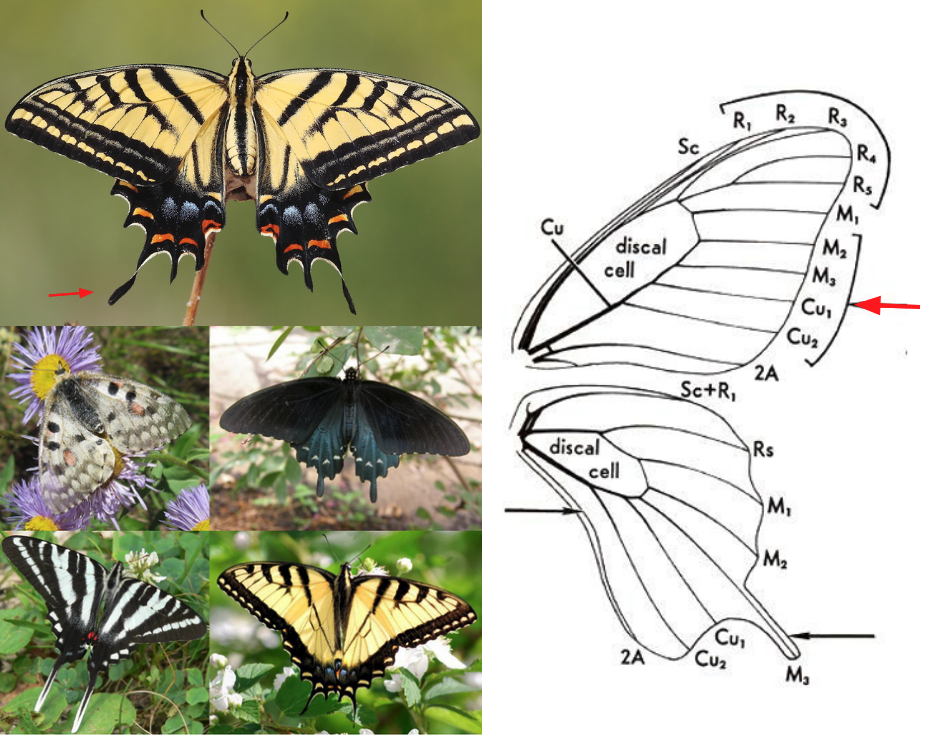
Order: Lepidoptera
Family: Pieridae (Whites & Sulfurs)
Front legs not or only slightly reduced
FW with R 3- or 4-branched
M1 of FW stalked with a branch of R near wing tip
HW with 2 anal veins and no tail
Size medium, usually plain white, yellow, or orange, sometimes marked with black
Tarsal claws bifurcate

Order: Lepidoptera
Family: Lycaenidae (Blues, coppers & hairstreaks)
Front legs of males usually reduced
FW with R 3- or 4-branched
M1 usually not stalked with a branch of R in FW
HW with 2 anal veins, occasionally with very tiny hair-like tail
Size small, very delicate, often brightly colored but not usually with or yellow
Tarsal claws simple, not bifurcate
Eyes and antennae contiguous
Eyes usually notched around antennal base
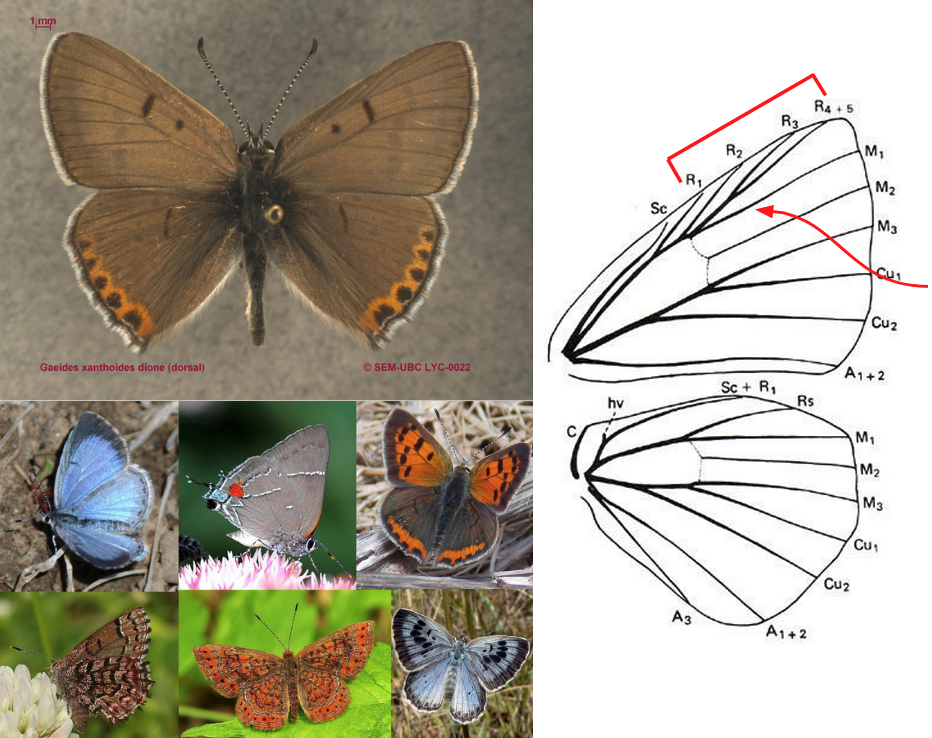
Order: Lepidoptera
Family: Nymphalidae (Brush-footed butterflies)
Front legs greatly reduced
FW with R 5-branched
M1 usually not stalked with a branch of R in FW
HW with 2 anal veins and no tail
Discal cell in HW often open or weakly closed (closed in Danainae)
Large or medium-sized, variable in color and shape
Tarsal claws simple, not bifurcate
Eyes and antennal base not contiguous
Eyes not notched around antennae
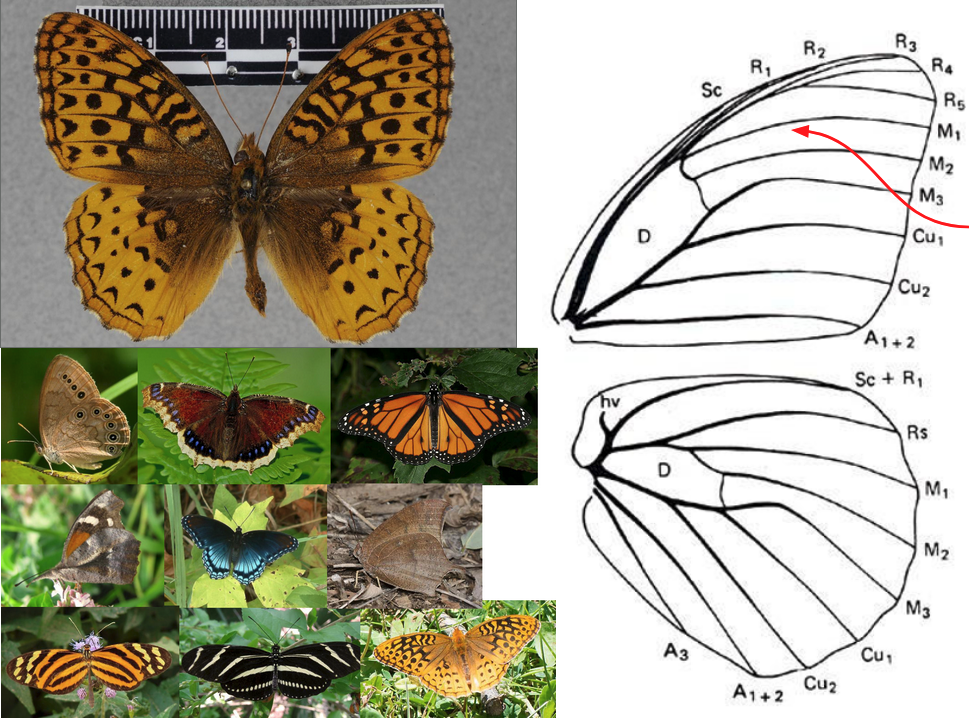
Order: Lepidoptera
Family: Psychidae (Bagworm moths)
Males winged, usually black with fairly short, clear wings with few scales
Females wingless or with stubby wings

Order: Lepidoptera
Family: Attevidae (Tropical ermine moths) (Formerly Yponomeutidae)
Distinct brightly colored, orange with black-ringed white spots
Large-ish accessory cell
Head and labial palps with smooth scales
Ocelli absent
Maxillary palps large, 1- to 2- segmented
Wings slightly narrowed, tips relatively blunt
Size small to medium
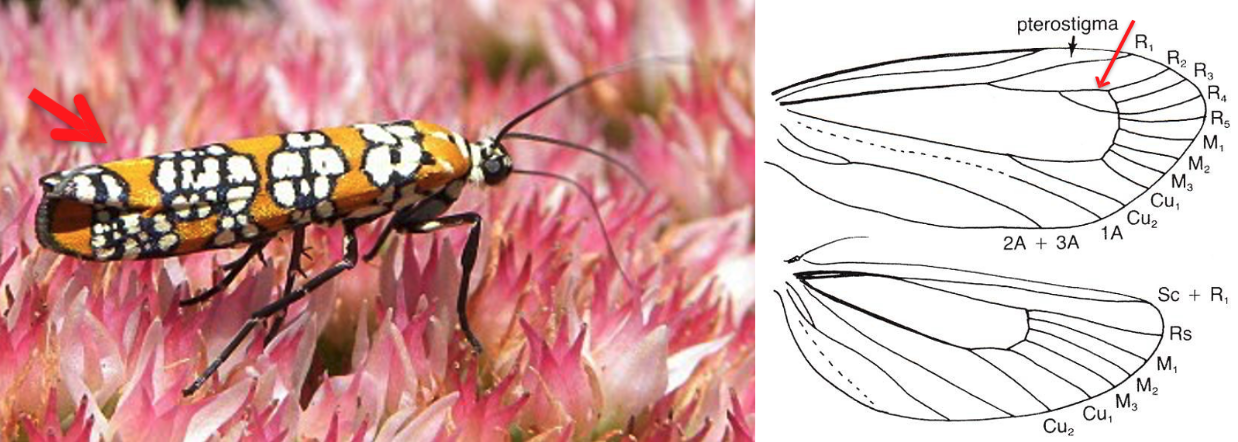
Order: Lepidoptera
Family: Tortricidae (Leaf-roller & fruitworm moths)
Maxillary palps small, labial palps, usually project forward
FW broad, somewhat “round-shouldered”, with squared-off tips
Difficult to distinguish from other families, however
Wings at rest usually held roof-like over the body
Size fairly small to medium
Often with complex patterns on FW and plain HW
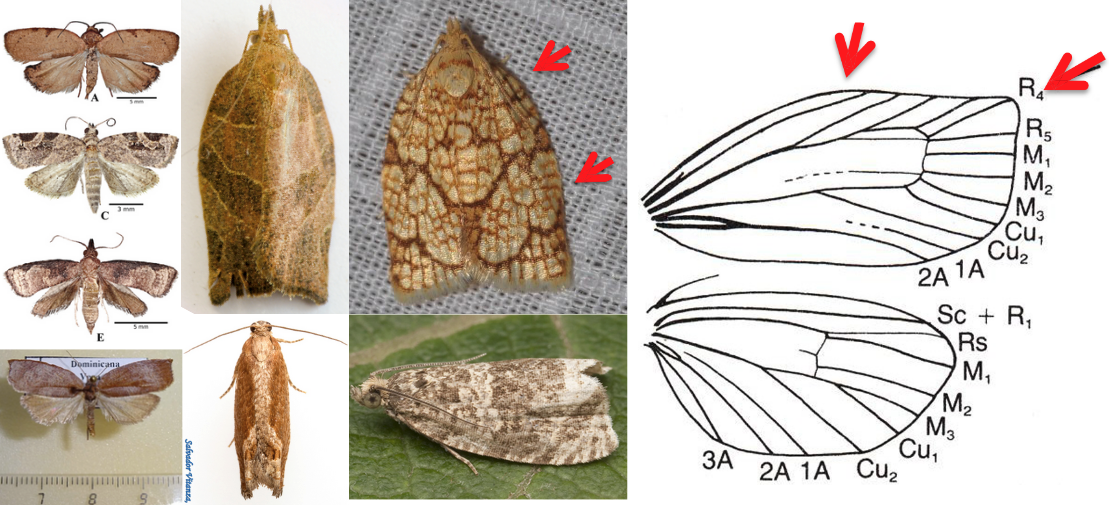
Order: Lepidoptera
Family: Pterophoridae (Plume moths)
Wings held perpendicular to body at rest, giving T-shaped profile
FW with 2 lobes; HW with 3 deep lobes, usually fringed, held beneath FW at rest
Legs long and slender, usually with projecting spines or spurs at joints
Slender, delicate moths
Usually gray or brown in color, some with more complex patterns
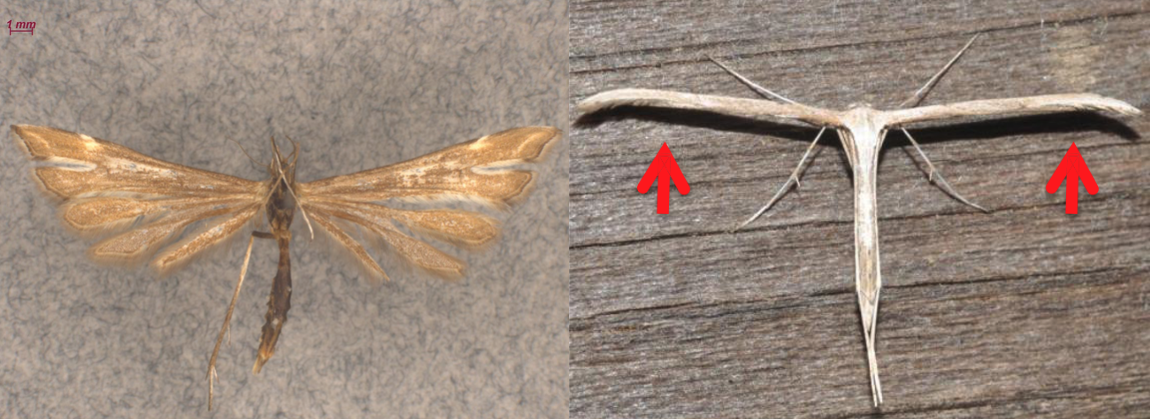
Order: Lepidoptera
Family: Sesiidae (Clearwing moths)
Antennae widen gradually, then narrow at tip
Ocelli conspicuous
Transparent, scaleless “windows” on wings
HW broad with anal area well developed (1A-3A)
Size small to medium
Often wasp-like in shape and coloring
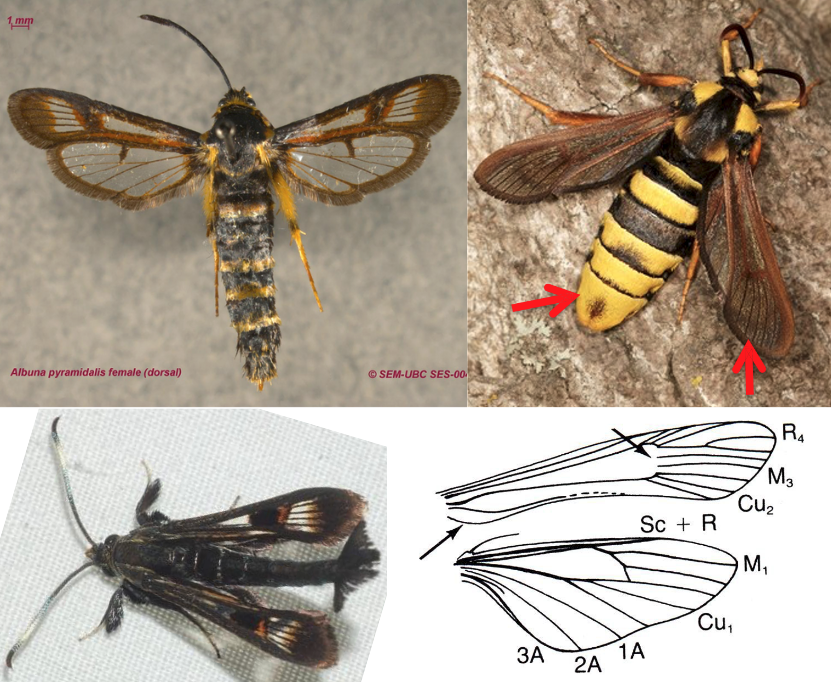
Order: Lepidoptera
Family: Limacodidae (Slug caterpillar moths)
Wings broadly rounded
FW with 2 complete anal veins
HW with 3 anal veins (1A-3A)
Sc and R1 in HW separate at base, then briefly fused
Stout-bodied, hairy, usually brown/green or brown/silver
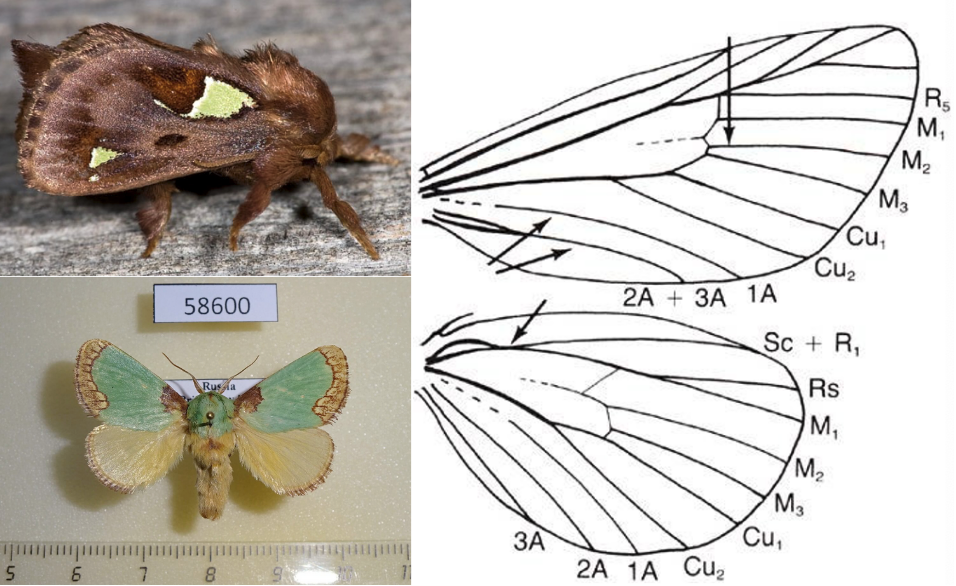
Order: Lepidoptera
Family: Gelechiidae (Twirler moths)
Head with smooth scales
Proboscis scaled
Maxillary palps short, 4-segmented
Labial palps long, upcurved, 3rd segment elongate and tapering
FW with R4 and R5 stalked at base and A1+2 forked at base
HW acute ateroapically, end of wing below apex concave
Long hairs on tibia
Size small to medium (Wingspan 7-25 mm)

Order: Lepidoptera
Family: Pyralidae (Snout moths)
Proboscis scaled
Labial palps often large and projecting forward (“snout”)
Maxillary palpi 3 or 4-segmented
HW more rounded and often broader than elongate-triangular FW
FW with Cu appearing 4-branched
HW with 3 anal veins and Sc + R1 and Rs fused byond discal cell, then separating
Size small to medium (wingspan 9-37 mm)
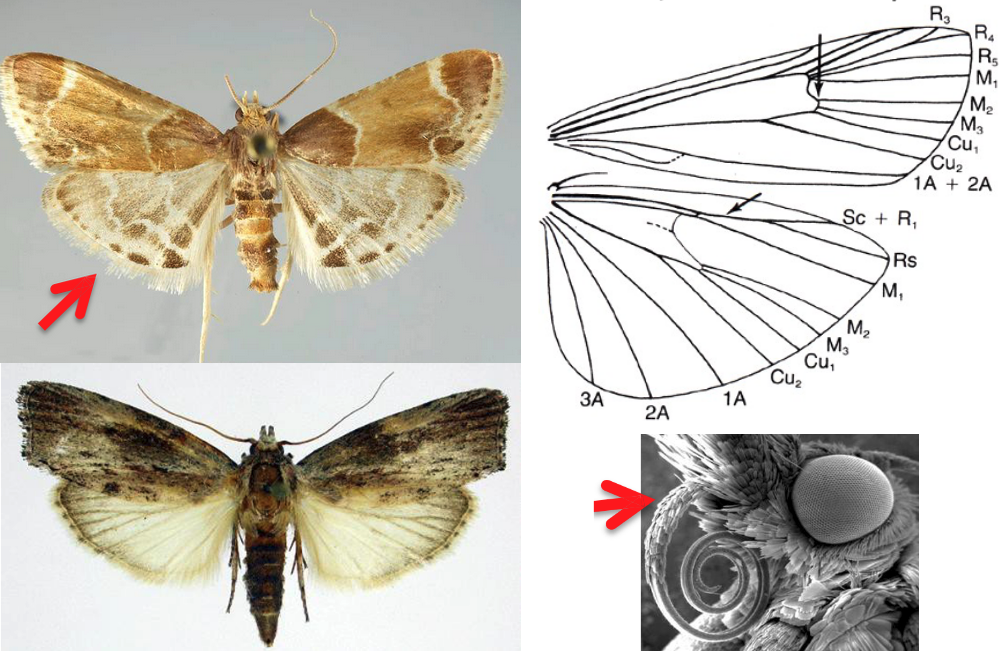
Order: Hymenoptera
Subfamily: Dolichoderinae (odorous ants)
Postpetiole absent, waist with a petiole
Apex of abdomen with a transverse slit-like opening (no fringe of hairs)
Antennae not clubbed; sockets not covered by lobes
Constriciton between abdominal segments 3 and 4 absent
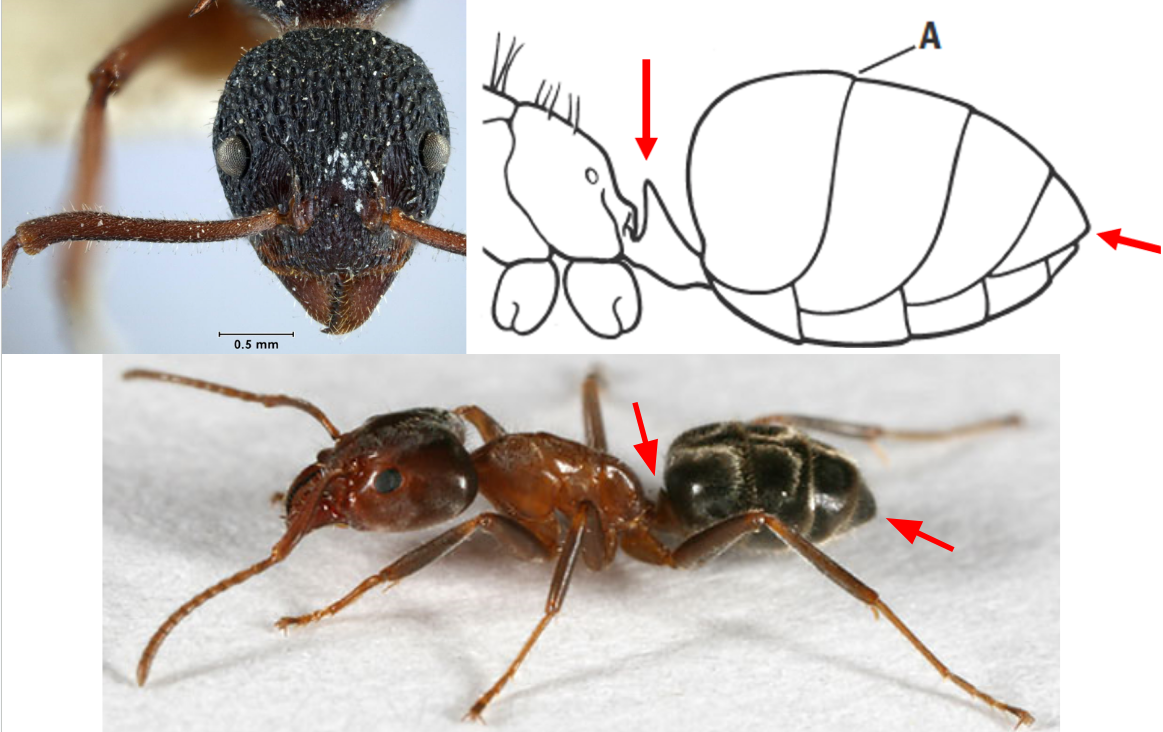
Order: Hymenoptera
Subfamily: Formicinae
Postpetiole absent, waist with a petiole
Apex of abdomen with a circular opening, usually surrounded by a fringe of hairs
Sting absent
Atennae not clubbed, sockets not covered by lobes
Constriction between abdominal segments of 3 and 4 absent
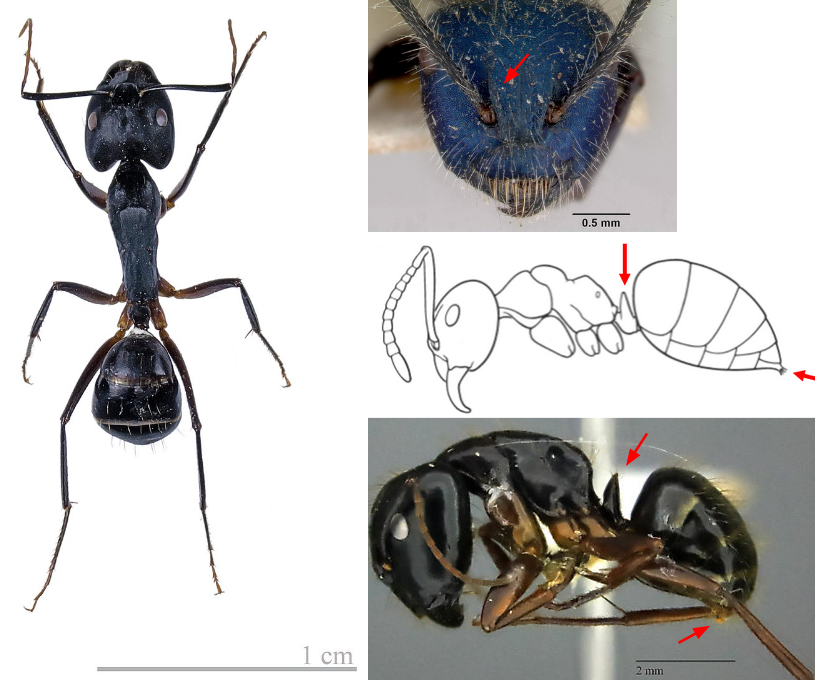
Order: Hymenoptera
Subfamily: Myrmicinae (Myrmicines)
Postpetiole present, waist 2-segmented
Antennal sockets covered by frontal lobes
Sting sometimes present
Apex of abdomen may also have fringe of hairs
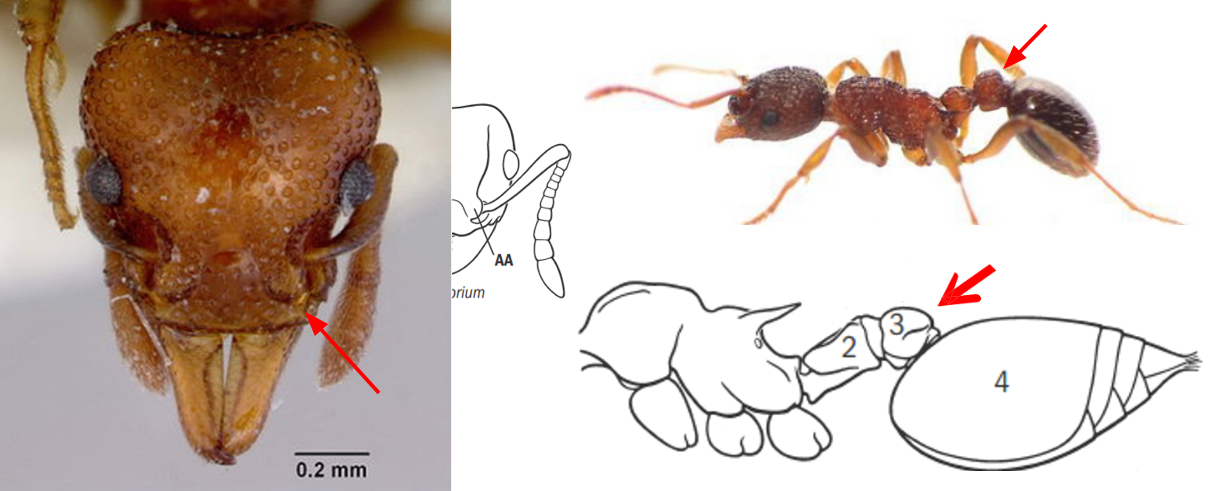
Order: Hymenoptera
Family: Andrenidae (Mining bees)
Face with two subantennal sutures (often covered by hairs)
Often with facial foveae (vertical depressions next to the inner margin of each compound eye)
“Tongue” short, pointed apically
Basal vein of FW not strongly arched
Jugal lobe of HW long
Small to medium-sized, often (not always!) with hairier thorax than Halictidae
Eye margin parallel, minimally angled
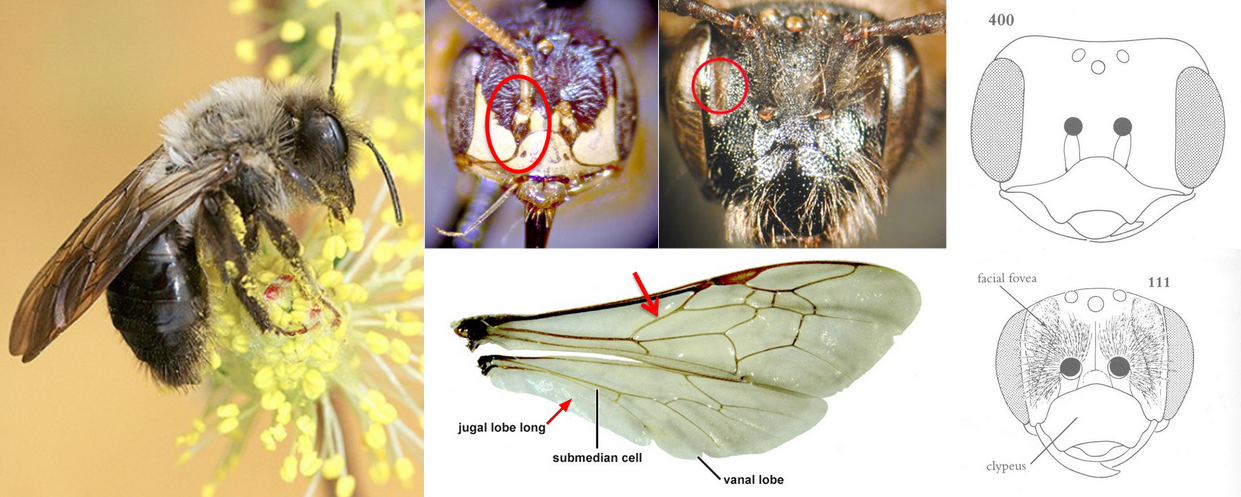
Order: Hymenoptera
Family: Colletidae (Plasterer & yellow-faced bees)
Face with one subantennal suture, meeting inner margin of antennal socket
“Tongue” short, bilobed at apex
Basal vein of FW strongly sigmoid (s-shaped)
Jugal lobe of HW long
Small to medium-sized, sparsely to quite hairy
Eye margins angled inward
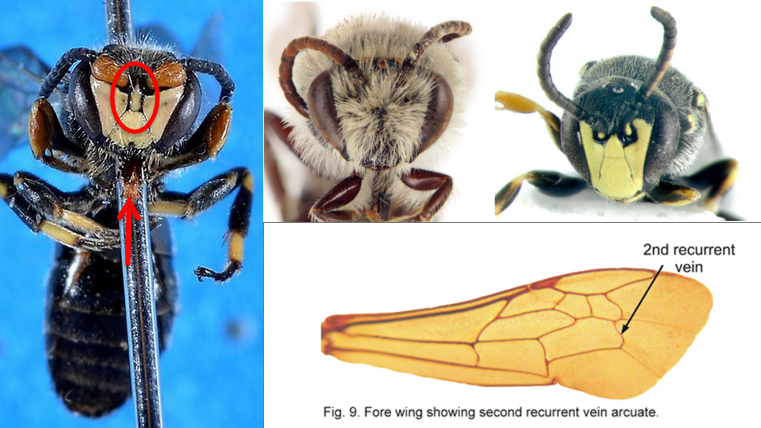
Order Hymenoptera
Family: Halictidae (sweat bees)
Face with one subantennal suture, meeting inner margin of antennal socket
“Tongue” short, pointed or rounded apically
Basal vein of FW strongly arched
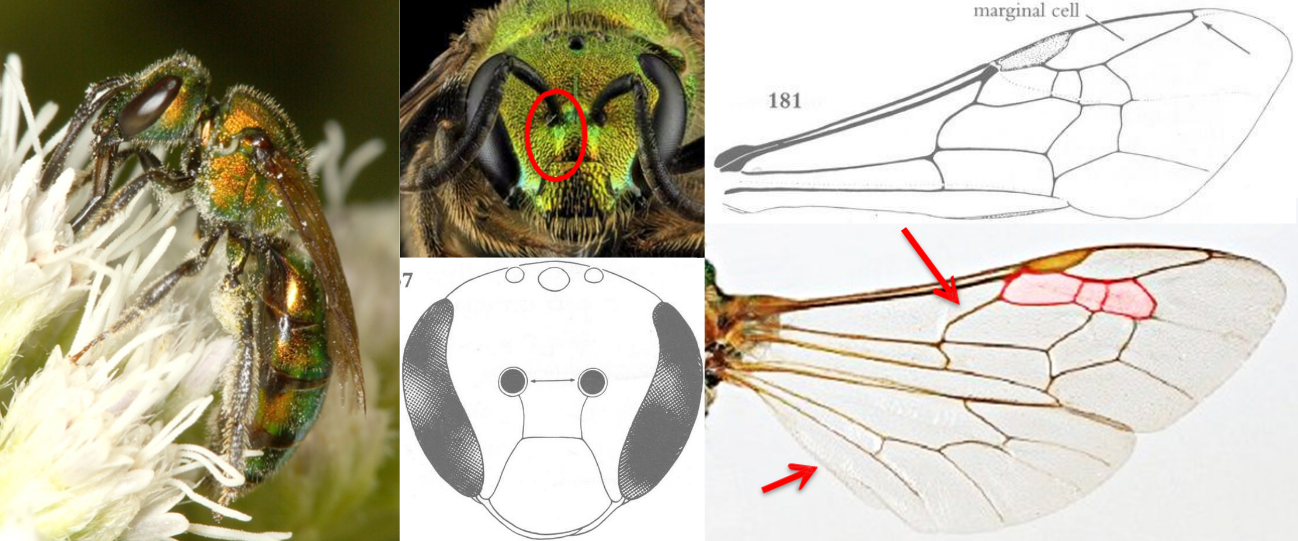
Order: Hymenoptera
Family: Megachilidae (Leaf-cutting bees)
Face with one subantennal suture, meeting outer margin of antennal socket
Females with scopa on venter (bottom) of abdomen
Labrum longer than broad, “tongue” long
FW with 2 submarginal cells, usually equal in length
Jugal lobe of HW short
Very variable in color, shape, size (sorry)
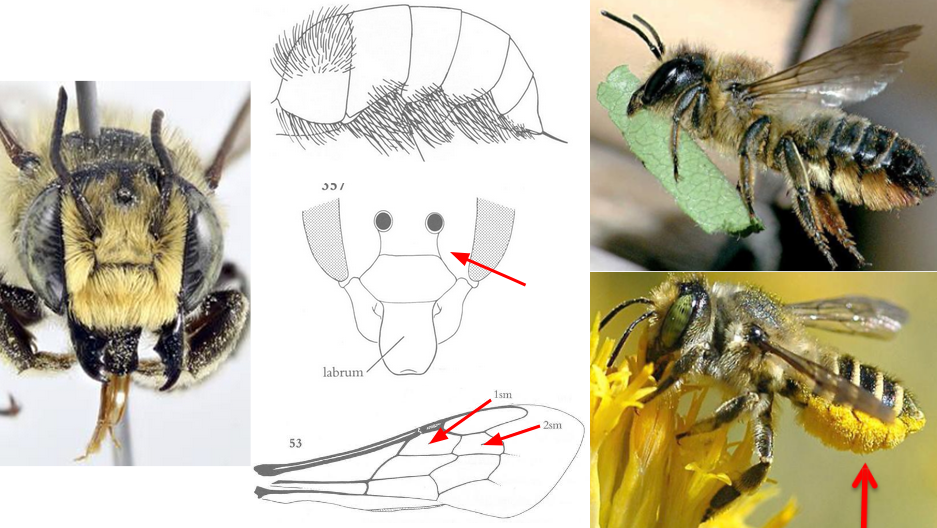
Order: Hymenoptera
Family: Apidae (Cuckoo, carpenter, & corbiculate bees)
Face with one subantennal suture, meeting inner margin of antennal socket
“Tongue” long with developed maxillary palps
FW with 3 submarginal cells (rarely 2)
Jugal lobe of HW usually present but short
Scopa brush-like on hind tibia (when present)
Variable size, form, color, often stout (it’s bad!)
If a honeybee, will have hair on its eyes
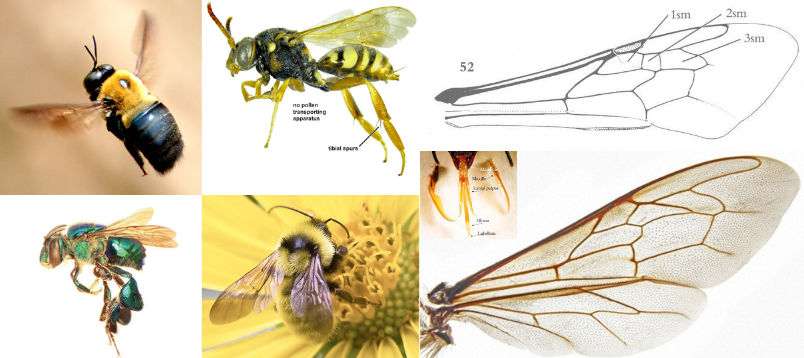
Order: Lepidoptera
Family: Lasiocampidae (Tent moths, lappet moths)
Antennae bipectinate in both sexes
Proboscis vestigial or absent
FW with Cu2 arises in the basal half of the discal cell
Frenulum absent but humeral area of hind wing greatly expanded
Stout, hairy bodies, most are brown or grey in color
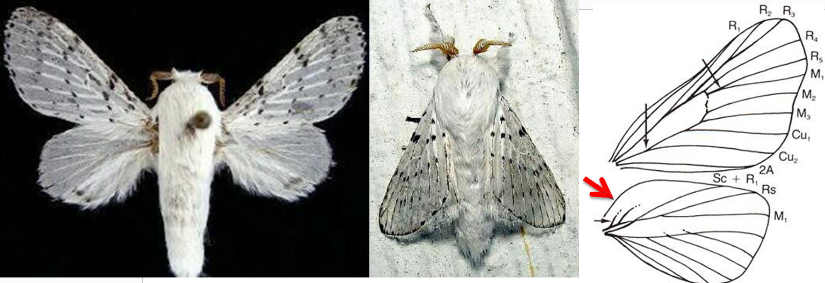
Order: Lepidoptera
Family: Saturniidae (Giant silk moths)
Antennae simple, pectinate, or bipectinate
Proboscis reduced or absent wings very broad
Wings very broad
No crossvein above discal cell in HW
Short, thick, densely hairy body
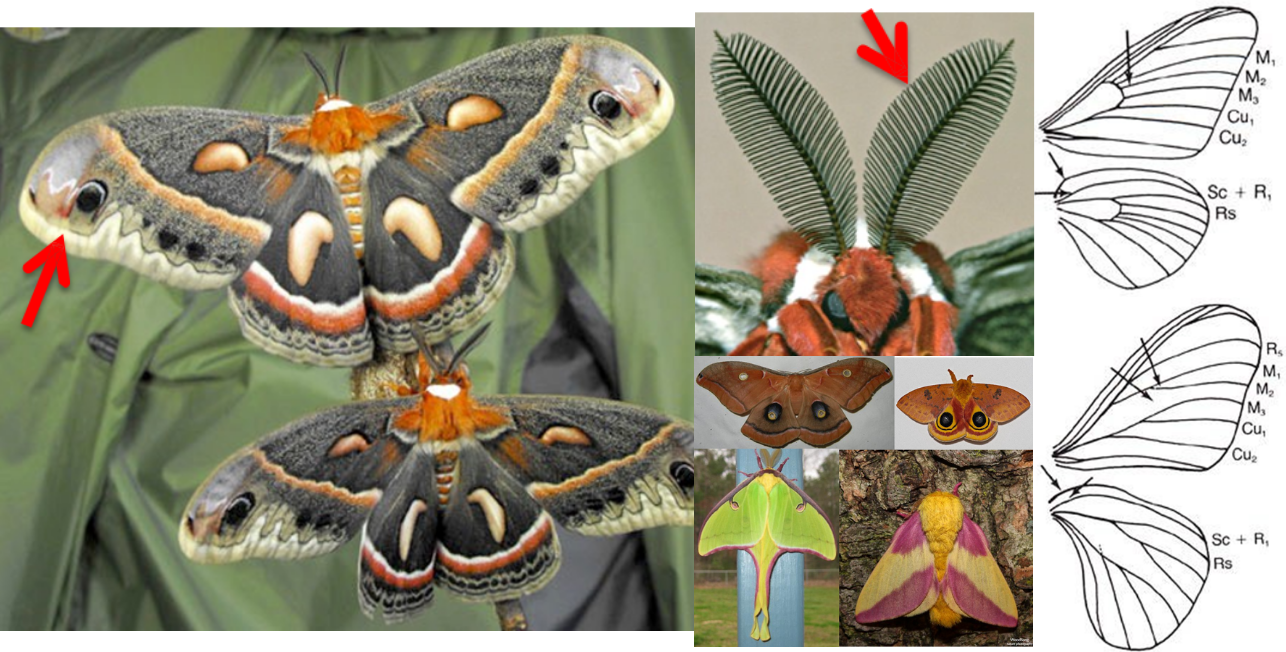
Order: Lepidoptera
Family: Sphingidae (Hawk moths)
Antennae thickened, somewhat spindle-shaped
Proboscis long, prominent
No ocellie or tympanal organs
FW usually much larger than HW
HW with small cross-vein midway along top of discal cell connecting Sc and R
Body very robust, spindle-shaped, abdomen often pointed
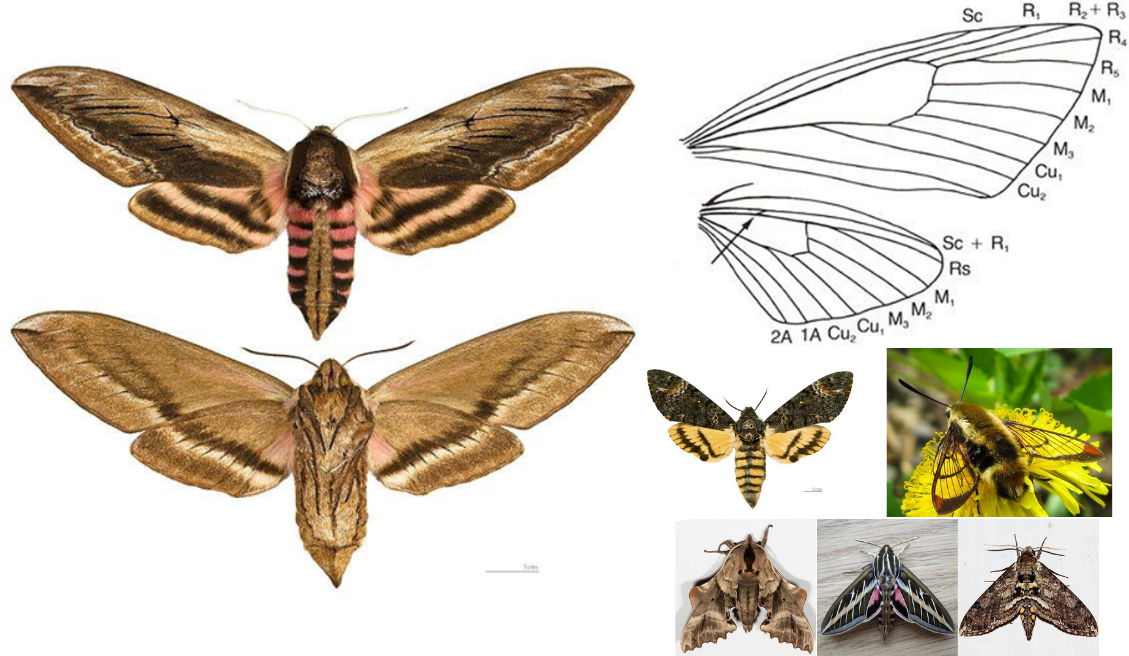
Order: Lepidoptera
Family: Geometridae (Geometers & Loopers)
Antennae threadlike or pectinate, not clubbed
HW with Sc with abrupt angle basally
Somewhat butterfly-like in shape with broad wings and slender body
Usually cryptically colored, wings often with find wavy lines

Order: Lepidoptera
Family: Notodontidae (Prominents)
Antennae usually bipectinate, occasionally simple
FW usually conspicuously longer than HW
In both wings, M2 arises from middle of the apex of discal cell, thus cubitus appearing 3-branched
Hw with Sc+R1 NOT touching RS: no areole
Thoracic tympana present, pointing downward
Some species with dorsal tuft on posterior margins of wings, protrudes at rest
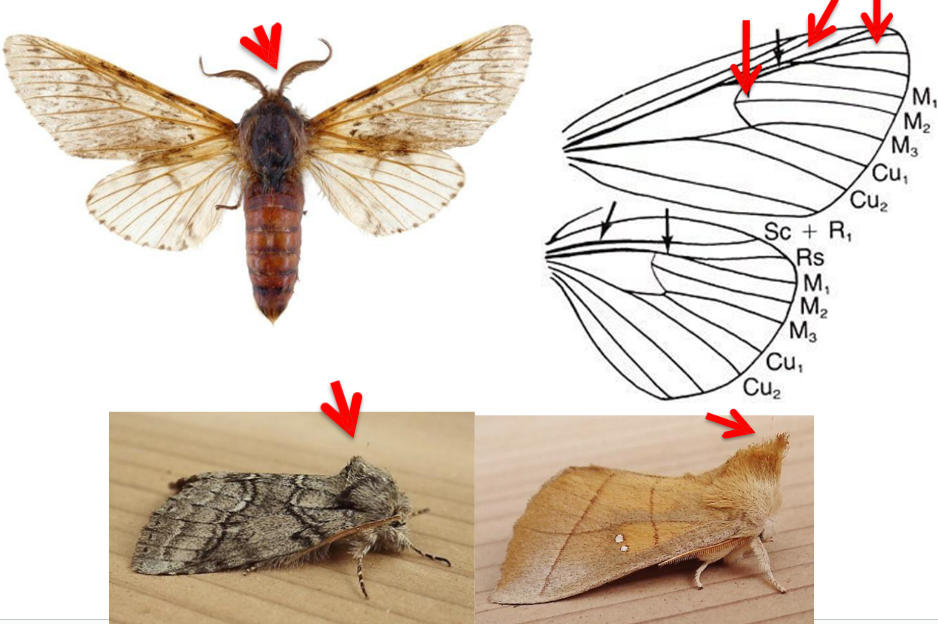
Order: Lepidoptera
Family: Noctuidae (Owlet moths & armyworm moths)
Antennae usually simple, occasionally bipectinate
Labial palps usually relatively long, upturned
FW somewhat narrowed, HW broadened
Very similar to Notodontidae, but the M2 in FW arises closer to the M3 at the apex of the discal cell, thus cubitus appears 4-branched
Very small cell (basal areole) at bae of discal cell in HW
Thoracic tympana present! on metathorax pointing back or outwards with tmpanal hood behind spiracle
Usually cryptically colored
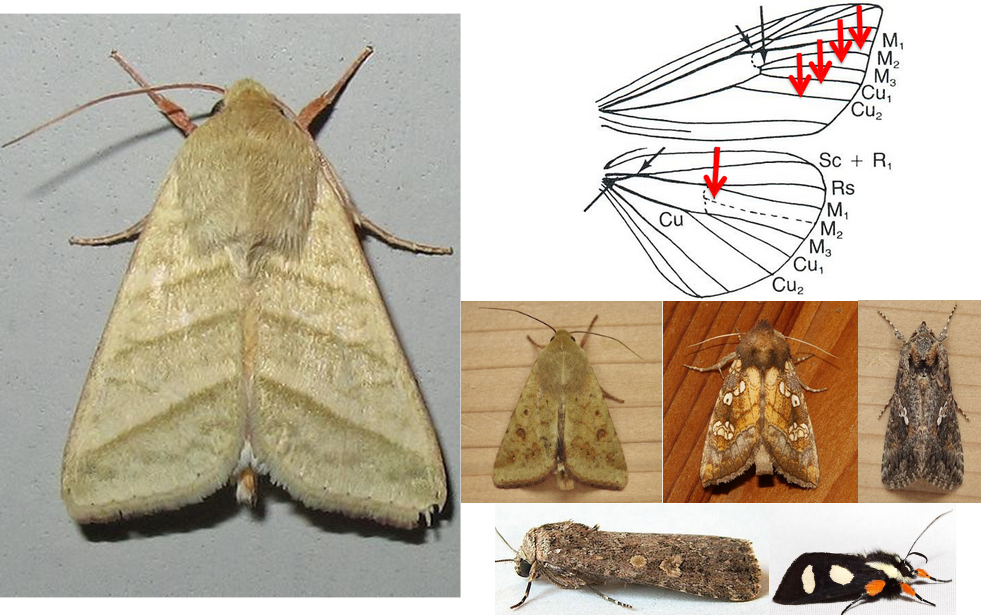
Order: Lepidoptera
Family: Erebidae
antennae bipectinate or simple (former in both sexes of Lymantriinae)
proboscis reduced or absent in some groups (like Lymantriinae)
labial palps short or well-developed (former in Arctiinae, latter
in Lymantriinae)
very similar to Notodontidae and Noctuidae, but the M2 in both wings arise closer to the M3 at the apex of the discal cell, thus cubitus appears 4-branched: "quadrifid"
hind wing with Sc+R1 joining Rs for a short distance, forming
larger basal areole than in Noctuidae
thoracic tympana present! tympanum on metathorax pointing backwards with tympanal hood in front of spiracle
size medium, with relatively large body
highly variable, often brightly-colored moths; Lymantriinae are
brown, gray, or white
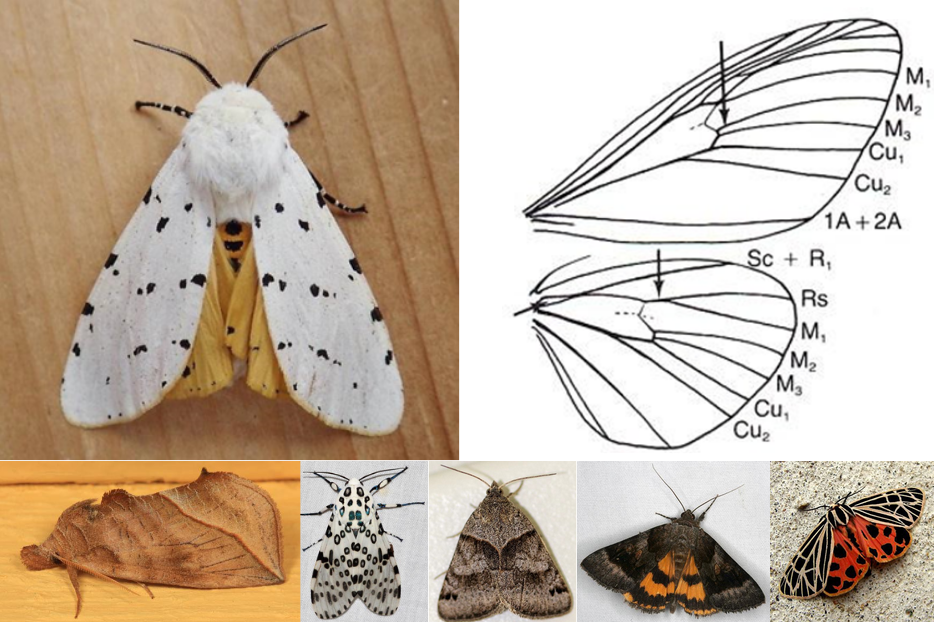
Order Neuroptera
Family: Myrmeleontidae (Antlions)
Antennae short and gradually expanding, without distinct knob
Abdomen long & slender, superficially resembling Odonata
Eyes large, not notched
Cerci absent
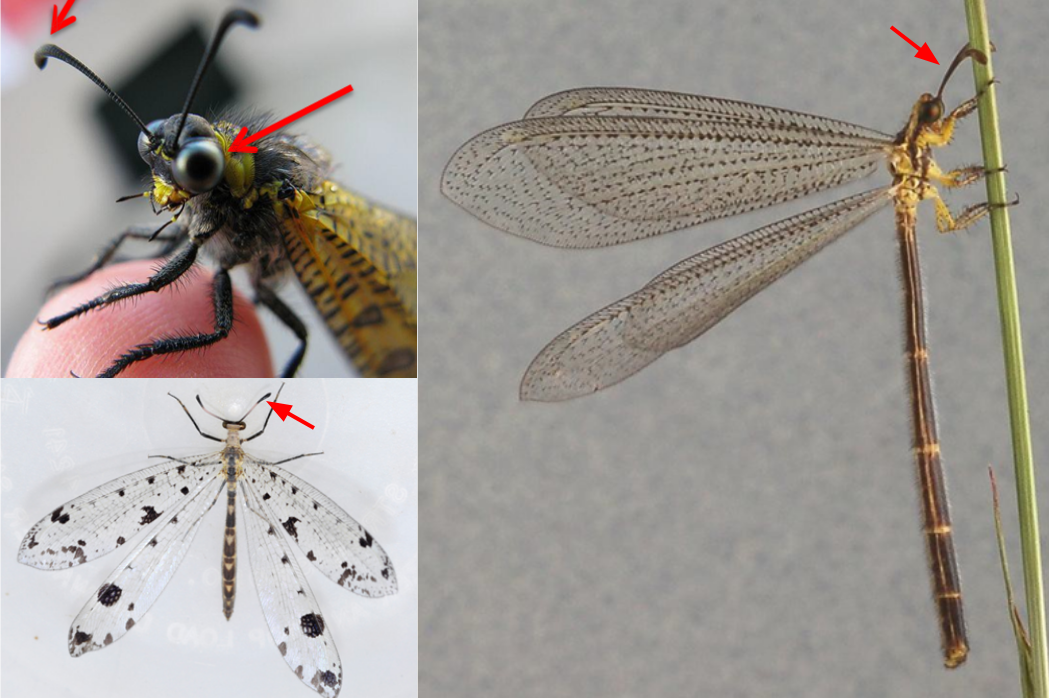
Order Neuroptera
Family: Ascalaphinae (Owlflies)
Antenae long with distinct knob
Abdomen long & slender, superficially resembling Odonata
Eyes large, bulge outwards from head
Eyes sometimes notched
Cerci absent
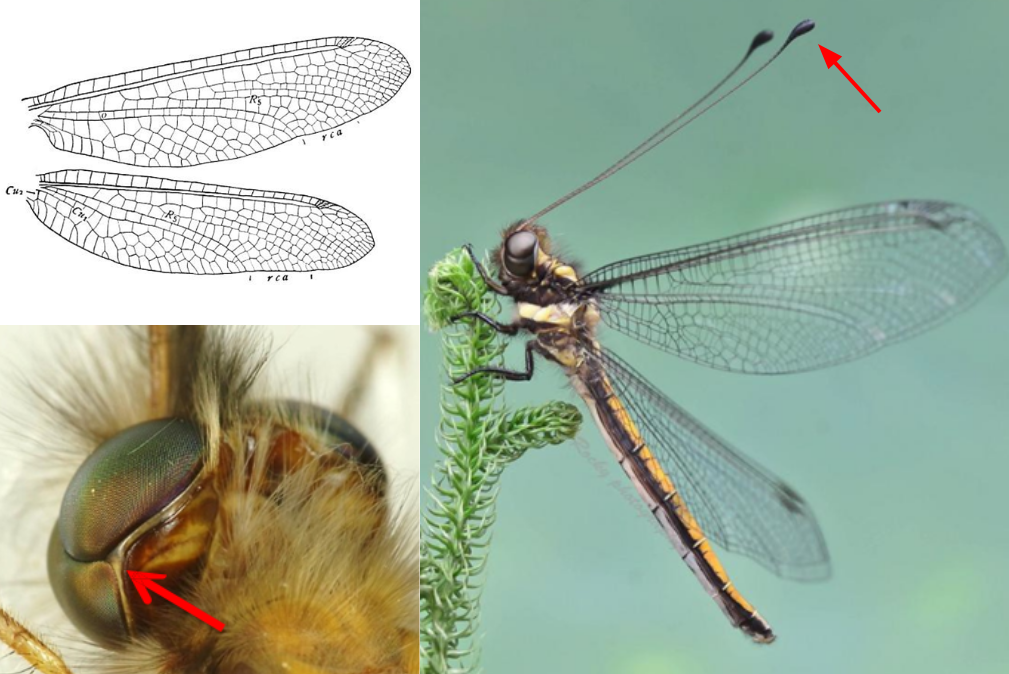
Order: Neuroptera
Family: Mantispidae (Mantidflies)
Prothorax elongate (only family)
Front legs raptorial (only family)
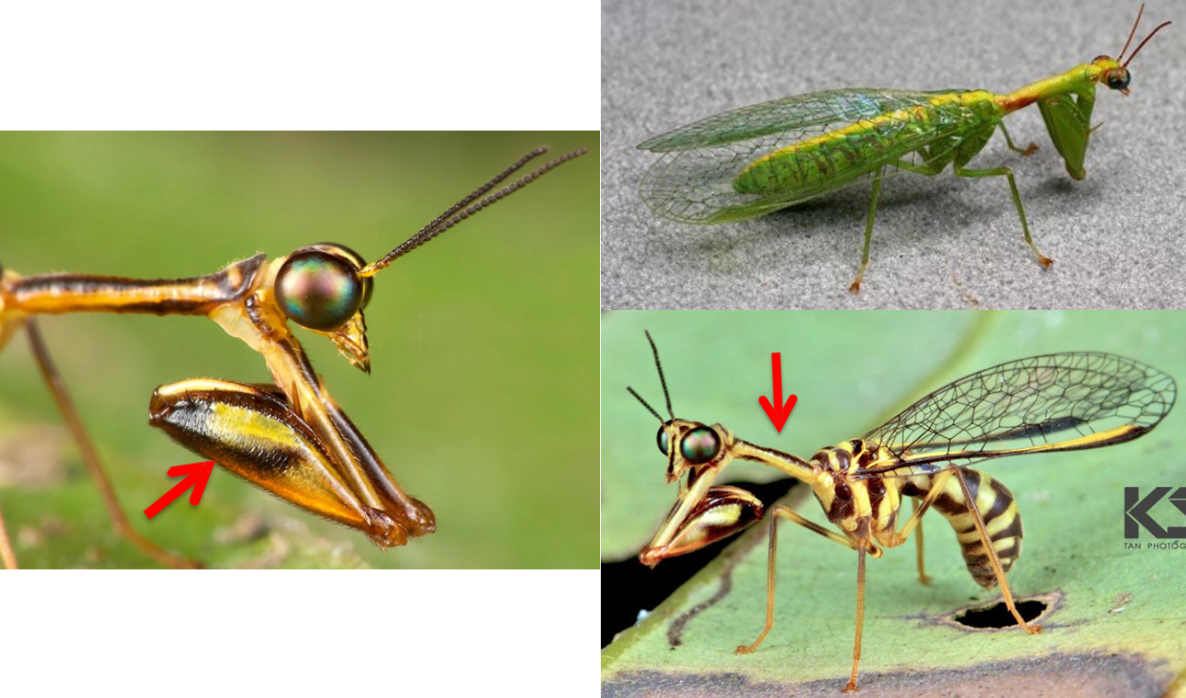
Order: Neuroptera
Family: Chrysopidae (Green lacewings)
Crossveins along anterior margin of wing unbranched
Wing venation generally more honeycomb-like
OFten, but not always, green
Subcostal and R1 vein free distally

Order: Neuroptera
Family: Hemerobiidae (Brown lacewings)
Crossveins along anterior margin of wing forked
Wing veins generally more longitudinal
Common species smaller
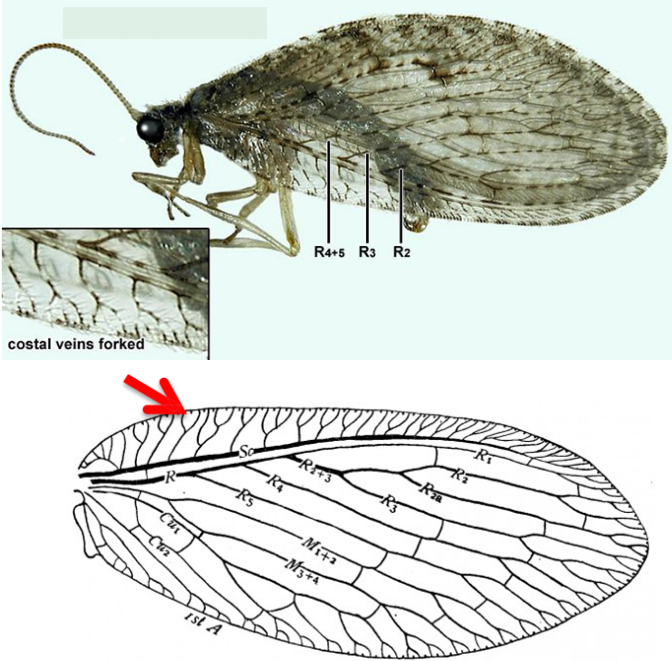
Order: Raphidioptera (snakeflies)
Family: Raphidiidae (Typical snakeflies)
Prothorax elongated
Head elongate and flattened
Female with elongate ovipositor
Front legs aris from posterior end of prothorax and are similar to other legs
FW and HW similar in shape and size
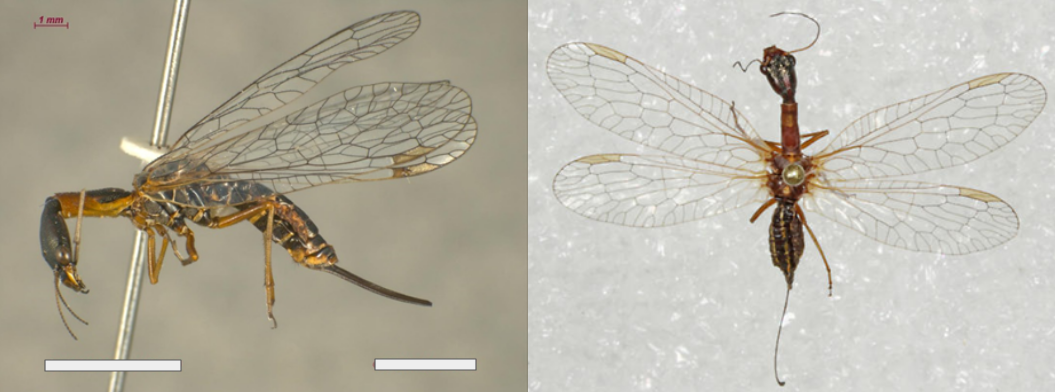
Order: Mecoptera (Scorpionflies)
Synapomorphies
antennae filiform, with 14 or more segments
head (specifically clypeus) prolonged below eyes as a “beak”
mandibulate mouthparts
usually 2 pairs of long membranous wings, similar in shape
wing venation somewhat like Neuroptera, except Cu1 and M fused for short distance in hind wing
tarsi 5-segmented
holometabolous
Order: Mecoptera
Family: Panorpidae (Common scorpionflies)
Wings fairly broad at base
Tarsi non-raptorial, with two small claws, 5th segment not folding
Male with scorpion-like “tail” (genitalia)
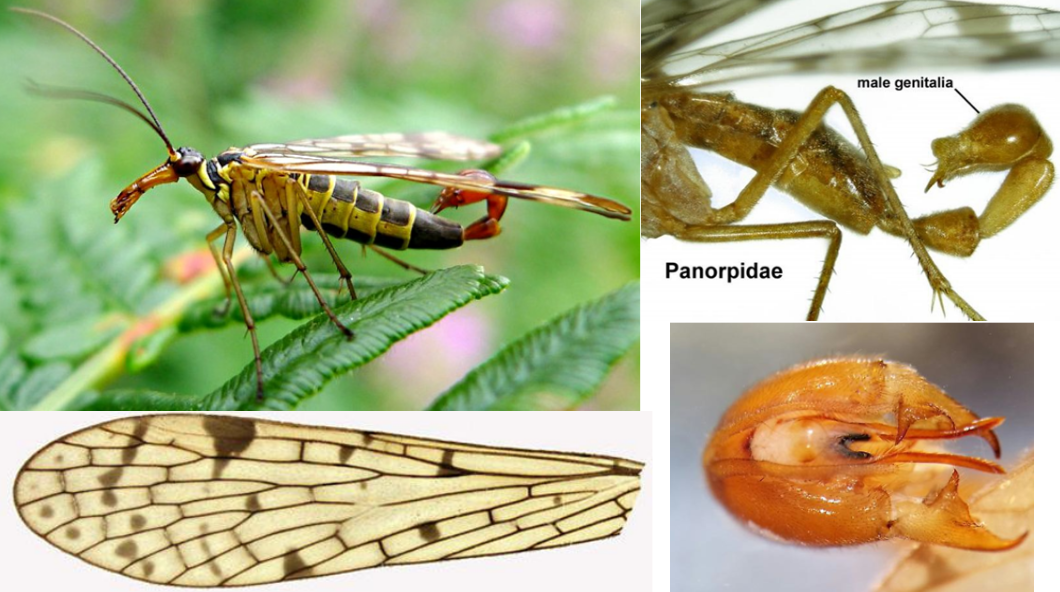
Order: Siphonaptera (Fleas)
mouthparts haustellate
wings completely absent
meta- (hind) coxae enlarged for jumping
body small, laterally compressed
usually with strong caudally directed setae
holometabolous
